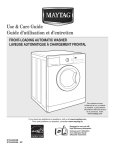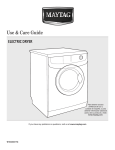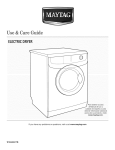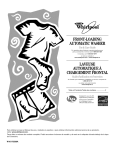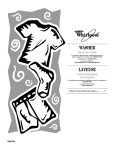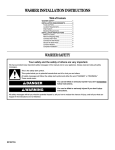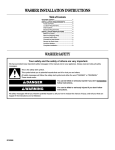Download Washer Installation Instructions
Transcript
Optional tools: INSTALLATION INSTRUCTIONS INSTALLATION REQUIREMENTS Tools and Parts Gather required tools and parts before starting installation. Tools needed: Flashlight Bucket Options: Pedestal: You have the option of purchasing a pedestal for this washer. You may select an 11.8" (300 mm) pedestal. The pedestal will add to the total height of the washer. Adjustable or open end wrenches 15/32" (12 mm) and 1/2" (13 mm) Level 4" min (102 mm) Wood block Ruler or measuring tape Pedestal Height Approximate Height with Washer Color Model Number 11.8" (300 mm) 44.7" (1135 mm) White LAB0050PQ Alternate parts: (Not supplied with washer) Pliers that open to 19⁄16" (39.5 mm) Your installation may require additional parts. To order, please refer to toll-free numbers on the back page of this manual. Parts supplied: If you have: NOTE: All parts supplied for installation are in the washer basket. Cable tie U-shaped hose form Laundry tub or standpipe Sump pump system (if not already taller than 55" (1.4 m) available) Overhead sewer Standard 20 gal. (76 L) 30" (762 mm) tall drain tub or utility sink, sump pump and connectors (available from local plumbing suppliers) Floor drain system Siphon Break Kit Part Number 285834 Connector Kit (x2) Part Number 285835 Additional Drain Hose Part Number 8318155 Drain hose too short Extension Drain Hose Part Number 285863 Connector Kit Part Number 285835 Water faucets beyond reach of fill hoses 2 longer water fill hoses: 6 ft (1.8 m) Part Number 76314 10 ft (3.0 m) Part Number 350008 Inlet hoses (2) with washers Transport bolt hole plugs (4) You will need: Stack Kit: Are you planning to stack your washer and dryer? To do so you will need to purchase a Stack Kit. To order, call the dealer from whom you purchased your washer or refer to the “Assistance or Service” section. Ask for Part Number W10178021. 14 LOCATION REQUIREMENTS Proper installation is your responsibility. You will need: ! A water heater set to 120° F (49° C). ! A grounded electrical outlet located within 5.4 ft (1.7 m) of power cord on back of washer. ! Hot and cold water faucets located within 4 ft (1.2 m) of hot and cold water fill valves on washer, and water pressure of 20–100 psi (137.9–689.6 kPa). ! A level floor with maximum slope of 1" (25 mm) under entire washer. Installing on carpet or surfaces with foam backing is not recommended. ! Floor must support washer’s total weight (with water and load) of 400 lbs (180 kgs). IMPORTANT: Do not install, store or operate washer where it will be exposed to weather or in temperatures below 32° F (0° C). Water remaining in washer after use may cause damage in low temperatures. See “Washer Maintenance” for winterizing information. All dimensions show recommended spacing allowed, except for closet door ventilation openings which are the minimum required. For each arrangement, consider allowing more space for ease of installation and servicing, and spacing for companion appliances and clearances for walls, doors, and floor moldings. Space must be large enough to allow door to fully open. Add spacing of 1" (25 mm) on all sides of washer to reduce noise transfer. If a closet door or louvered door is installed, top and bottom air openings in door are required. Recessed area or closet installation (stacked washer and dryer): 12" (305 mm) 3" (76 mm) 48 in.2 (310 cm2) 653/4" (1670 mm) 237/16" (595 mm) 24 in.2 (155 cm2) 51/4" (133 mm) 3" (76 mm) 327/8" (835 mm) 1" (25 mm) 1" (25 mm) *External exhaust elbow requires additional space. Custom under counter installation: 39" min. (990 mm) 361/4"" (920 mm) 1" (25 mm) 20 / " (510 mm) 1 8 1" (25 mm) Custom cabinet installation: 7" (178 mm) 9" (229 mm) 4" (102 mm) 1" (25 mm) 1" (25 mm) 15 LOCATION REQUIREMENTS (cont.) Recessed area or closet installation (washer only): 34" 9" (229 (864 mm) 3" (76 mm) Recessed area or closet installation (washer on pedestal): 18" 9" (229 (457 mm) 3" (76 mm) 48 in.2 (310 cm2) 48 in.2 (310 cm2) 4411/16" (1135 mm) 2 24 in. (155 cm2) 4" (102 mm) 24 in.2 (155 cm2) 4" (102 mm) 3" (76 mm) 3" (76 mm) 1" (25 mm) 1" (25 mm) 1" (25 mm) 1" (25 mm) DRAIN SYSTEM Drain system can be installed using a floor drain, wall standpipe, floor standpipe, or laundry tub. Select method you need. Laundry tub drain system IMPORTANT: To avoid siphoning, only 41⁄2" (114 mm) of drain hose should be inside standpipe. Always secure drain hose with cable tie. Floor standpipe drain system Minimum capacity: 20 gal. (76 L). Top of laundry tub must be at least 30" (762 mm) above floor; install no higher than 55" (1.4 m) from bottom of washer. Minimum diameter for a standpipe drain: 2" (51 mm). Minimum carry-away capacity: 17 gal. (64 L) per minute. A 1/4" (6 mm) diameter to 1" (25 mm) diameter Standpipe Adapter Kit is available (Part Number 3363920). Top of standpipe must be at least 30" (762 mm) high; install no higher than 55" (1.4 m) from bottom of washer. If you have an overhead sewer and need to pump higher than 96 inches, a sump pump and associated hardware are needed. See “Alternate Parts”. Floor drain system Wall standpipe drain system Floor drain system requires a Siphon Break Kit (Part Number 285834), 2 Connector Kits (Part Number 285835), and an Extension Drain Hose (Part Number 285863) that may be purchased separately. See “Alternate Parts”. Minimum siphon break height: 28" (710 mm) from bottom of washer. (Additional hoses may be needed.) See requirements for floor standpipe drain system. 16 ELECTRICAL REQUIREMENTS INSTALLATION INSTRUCTIONS NOTE: To avoid floor damage, set washer onto cardboard before moving it. 1. Move washer ! A 120 volt, 60 Hz., AC only, 15- or 20-amp, fused electrical supply is required. A time-delay fuse or circuit breaker is recommended. It is recommended that a separate circuit breaker serving only this appliance be provided. This washer is equipped with a power supply cord having a 3-prong grounding plug. To minimize possible shock hazard, the cord must be plugged into a mating, 3-prong, grounding-type outlet, grounded in accordance with local codes and ordinances. If a mating outlet is not available, it is the personal responsibility and obligation of the customer to have the properly grounded outlet installed by a qualified electrician. If codes permit and a separate ground wire is used, it is recommended that a qualified electrician determine that the ground path is adequate. ! Do not ground to a gas pipe. ! Check with a qualified electrician if you are not sure the washer is properly grounded. Do not have a fuse in the neutral or ground circuit. 48" (1.2 m) It is necessary to remove all shipping materials for proper operation and to avoid excessive noise from washer. Move washer to within 48" (1.2 m) of its final location. It must be in a fully upright position. 2. Locate transport bolts Locate four transport bolts on rear of washer. 17 3. Remove transport bolts from washer Lo Loosen bolts with ith a 15/32" (12 mm) m) wrench. h. Once O th the bolt iis loose, move it to the center of the hole and completely pull out the bolt, including the plastic spacer covering the bolt. 6. Place power cord over top Remove the yellow shipping strap from the cord. Gently place power cord over top of washer to allow free access to back of washer. IMPORTANT: Do not plug washer in until installation has been completed. 4. Remove power cord ROUTE DRAIN HOSE Proper routing of the drain hose protects your floor from damage due to water leakage. Read and follow these instructions. 7. Remove drain hose from washer Pull power cord through opening in rear panel. NOTE: If washer is transported at later date, call your local service center to avoid suspension and structural damage, a certified technician must properly set up washer for relocation. 5. Cover bolt holes with transport bolt hole plugs Gently pull the corrugated drain hose from the shipping clips. Close bolt holes on cabinet back with four transport bolt hole plugs included with washer parts. 18 8. Connect laundry tub drain or standpipe drain hose form (floor drain installations only) CONNECT INLET HOSES Washer must be connected to water faucets with new inlet hoses with flat washers. Do not use old hoses. NOTE: Both hoses must be attached and have water flowing to inlet valves. For optimal performance, hot and cold water must be supplied to the washer. 10. Connect inlet hoses to water faucets For floor drain installations, you will need to connect the drain hose form to the end of the drain hose. You may need additional parts with separate directions. See “Alternate Parts”. 9. Place drain hose in standpipe Attach hose to hot water faucet. Screw on coupling by hand until it is seated on washer. Use pliers to tighten couplings an additional two-thirds turn. Repeat this step with second hose for cold water faucet. IMPORTANT: Do not overtighten or use tape or sealants on valve when attaching to faucets or washer. Damage can result. HELPFUL TIP: Make note of which hose is connected to hot water to help in attaching hoses to washer correctly. In most standard configurations, hoses will cross over each other when attached correctly. 11. Clear water lines Place hose into standpipe (shown in picture) or over side of laundry tub. IMPORTANT: Only 41⁄2" (114 mm) of drain hose should be inside standpipe; do not force excess hose into standpipe or lay on bottom of laundry tub. Drain hose form must be used. Run water for a few seconds through hoses into a laundry tub, drainpipe, or bucket to avoid clogs. Water should run until clear. 19 LEVEL WASHER 12. Connect inlet hoses to washer Leveling your washer properly reduces excess noise and vibration. 15. Check levelness of washer place level here Attach hot water hose to hot water inlet valve. Screw coupling by hand until it is snug. Use pliers to tighten couplings an additional two-thirds turn. Repeat with cold water inlet valve. IMPORTANT: To reduce risk of hose failure, replace the hoses every 5 years. Record hose installation or replacement dates for future reference. Periodically inspect and replace hoses if bulges, kinks, cuts, wear, or leaks are found. Remove cardboard from beneath washer. Place a level on top edges of washer, checking each side and front. If not level, tip washer and adjust feet up or down as shown in steps 17 and 18, repeating as necessary. 13. Check for leaks Not Level LEVEL Not Level 16. Rock washer to test foot contact Slowly turn on water faucets to check for leaks. A small amount of water may enter washer. It will drain later. 14. Secure drain hose Laundry Tub 41/2" 4.5" (114 mm) Standpipe 41/2" (114 mm) Wall 1/2" 44.5" (113 mm) (114 Secure drain hose to laundry tub leg, drain standpipe, or inlet hoses for wall standpipe with cable tie. 20 Grip washer from top and rock back and forth, making sure all four feet are firmly on floor. Repeat, rocking washer from side to side. If washer rocks, go to step 17 and adjust leveling feet. If all four feet are in firm contact with floor, go to Step 18. 17. Adjust leveling feet Jam nut If washer is not level, use a 1/2" or 13 mm open-end or adjustable wrench to turn jam nuts clockwise on feet until they are about 1/2" (13 mm) from the washer cabinet. Then turn the leveling foot clockwise to lower the washer or counterclockwise to raise the washer. Recheck levelness of washer and that all four feet are firmly in contact with the floor. Repeat as needed. 19. Plug into a grounded 3-prong outlet HELPFUL TIP: You may want to prop up front of washer about 4" (102 mm) with a wood block or similar object that will support weight of washer. 18. Tighten leveling feet Jam nut COMPLETE INSTALLATION CHECKLIST When washer is level and all four feet are firmly in contact with the floor, use a 15/32" or 12 mm open-end or adjustable wrench to turn jam nuts counterclockwise on leveling feet tightly against washer cabinet. HELPFUL TIP: You may want to prop washer with wooden block. " Check electrical requirements. Be sure you have correct electrical supply and recommended grounding method. " Check that all parts are now installed. If there is an extra part, go back through steps to see what was skipped. " " Check that you have all of your tools. " Check that both hot and cold hoses are attached and water faucets are on. " " Check for leaks around faucets, valves, and inlet hoses. " Check that washer is plugged into a grounded 3-prong outlet. " " " Dispose of/recycle all packaging materials. Check that transport materials were completely removed from back of washer. Remove protective film from console and any tape remaining on washer. Read “Using Your Washer.” To test and clean your washer, turn on the washer and choose the Normal cycle and run it without clothes. Use only HE detergent. Use 1/2 the manufacturer’s recommended amount for a medium-size load. 21








